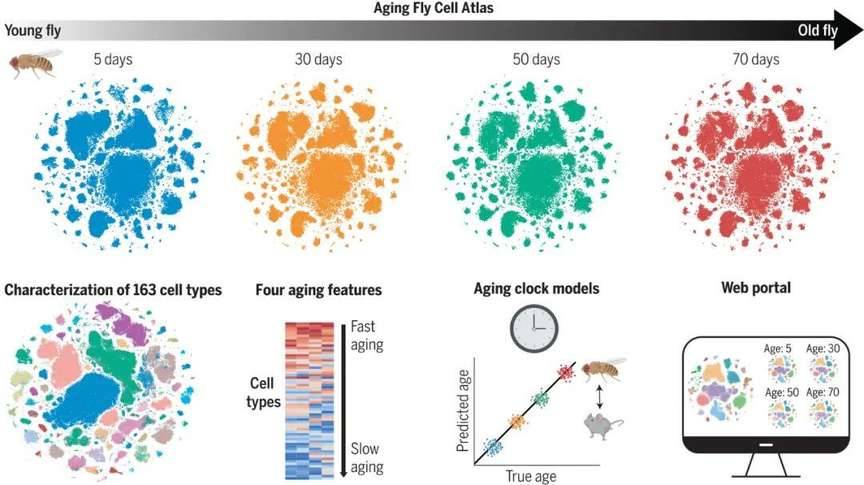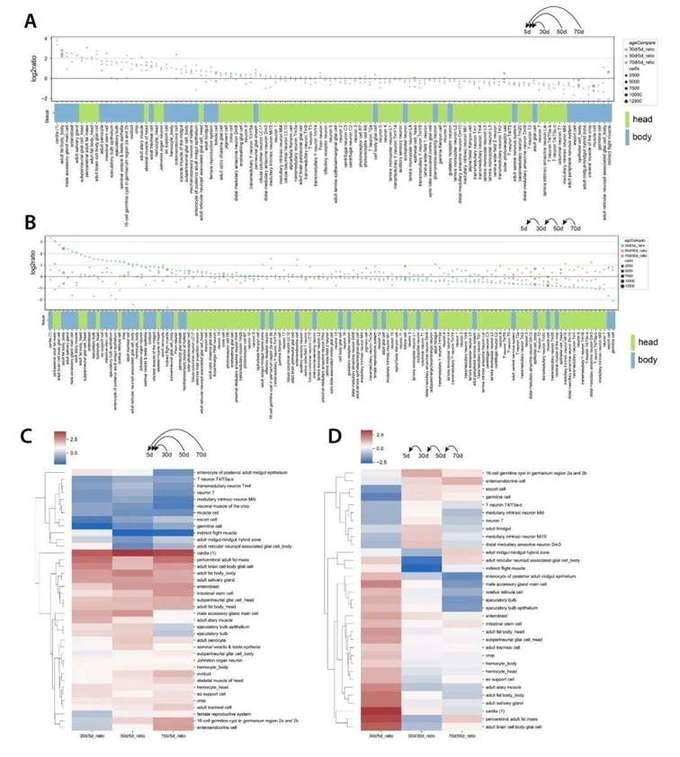Aging is a natural process in multicellular life, and many phenotypes associated with aging are conserved in mammals and other animals. This process increases the risk of developing various diseases, such as cardiovascular disease, neurodegenerative diseases and cancer. Although there is a long history of aging-related research and several aging hypotheses have been proposed, there is still a limited understanding of the effects of aging on the composition and maintenance of different cell types. It is also unclear whether all cell types age at the same rate, or whether the transcriptome of a cell type can be used to predict age. Furthermore, the genes and signaling pathways that lead to senescence in different cell types are not fully understood.
A recent article in Science, "Aging Fly Cell Atlas identifies exhaustive aging features at cellular resolution," shows that Drosophila melanogaster single-nucleus RNA sequencing was performed at multiple time points during the life cycle of the fly. The article identifies exhaustive aging features at cellular resolution. After examining more than 850,000 nuclei from 163 cell types, the team identified changes in gene expression and cell composition during aging, developed a model of the aging clock, and ranked the aging rate of different cell types in relation to four aging features. The atlas will serve as an important resource for studying the basic principles of aging in complex organisms.
Why Drosophila melanogaster?
Drosophila melanogaster plays a crucial role in advancing the fields of genetics, neurobiology, development and aging. Most of the genes associated with human diseases (about 75%) have functionally similar counterparts in Drosophila. Drosophila is also a common model organism for studying aging because it displays several age-related functional changes observed in humans, such as declines in motor activity, learning and memory, cardiac function, and fertility. Thus, a comprehensive understanding of the molecular and genetic mechanisms of age-related decline in Drosophila could provide valuable insights for aging studies in this species and other organisms, including humans.
The Aging Fly Cell Atlas
Advances in single-cell RNA sequencing technology and the creation of the Drosophila Cell Atlas (FCA) have made it possible to study the aging phenotype of Drosophila at the single-cell level. Building on the existing FCA, the team used RNA sequencing to generate a single-cell atlas of 5-day-old adult Drosophila and sequenced more than 868,000 nuclei from 163 cell types in the head and body tissues of male and female flies at 30, 50 and 70 days of age. Combining these data, the researchers created a single-nucleus transcriptome atlas of the different life cycles of Drosophila melanogaster, called the Aging Fly Cell Atlas (AFCA), characterizing the changes in most tissues of male and female Drosophila throughout their lives.
 Cell Atlas of Drosophila. (Lu et al., 2023)
Cell Atlas of Drosophila. (Lu et al., 2023)
By characterizing 163 cell types, the team compared these cell types for age-related changes in gene expression, changes in cell composition, and common pathways associated with aging. For example, different cell types in Drosophila age differently, with each following a process involving cell type-specific patterns; the neuroglobin 1 gene, a marker of indirect flight muscles in Drosophila, undergoes a dramatic decline with age. The team also developed an aging clock model to predict Drosophila aging from mononuclear transcriptome data, suggesting that ribosomal gene expression is a conserved age predictor. In addition, the study identified unique cell type-specific aging patterns, differences in the number of expressed genes and cell type characteristics during aging, with different cell types being differentially affected by different aging characteristics.
 Changes in cell type composition during aging in Drosophila. (Lu et al., 2023)
Changes in cell type composition during aging in Drosophila. (Lu et al., 2023)
AFCA provides an important resource for studying aging and age-related diseases, has the potential to serve as a reference for whole organism aging, can be used as a baseline for exploring different age-related diseases, and to understand at cellular resolution how different longevity perturbations can extend lifespan. The study will provide further insights into factors such as diet, drugs and disease that may alter aging trajectories, thus making organisms 'younger' or 'older' than their actual age.
Reference:
- Lu, Tzu-Chiao, et al. "Aging Fly Cell Atlas identifies exhaustive aging features at cellular resolution." Science 380.6650 (2023): eadg0934.
For research purposes only, not intended for clinical diagnosis, treatment, or individual health assessments.


 Sample Submission Guidelines
Sample Submission Guidelines
 Cell Atlas of Drosophila. (Lu et al., 2023)
Cell Atlas of Drosophila. (Lu et al., 2023) Changes in cell type composition during aging in Drosophila. (Lu et al., 2023)
Changes in cell type composition during aging in Drosophila. (Lu et al., 2023)